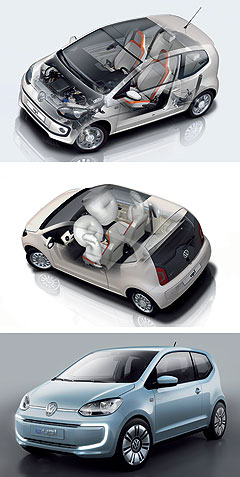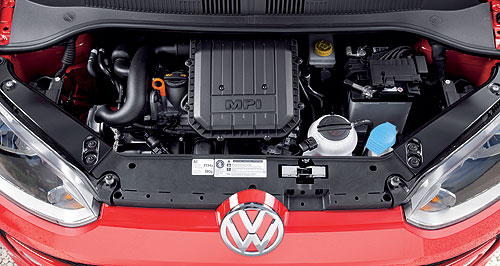Make / Model Search
Future models - Volkswagen - Up!Volkswagen Up triple treatTiny triple: The all-new Volkswagen three-cylinder engine used in the Up meets the latest Euro 5 emissions standard. All-new three-cylinder engine and advanced chassis tech for Volkswagen’s Up city car24 Oct 2011 IT MAY share the same 82mm bore spacings with the German giant’s volume-selling EA111 four-cylinder petrol engine family, but Volkswagen says the 1.0-litre three-cylinder engine that powers the upcoming Up is in fact all-new. Available in two power outputs, the EA211-series triple displaces 999cc and features some of the most advanced engine technologies to meet the latest Euro 5 emissions standard. The compact and lightweight all-aluminium three-pot, which drives the Up’s front wheels via a five-speed manual transmission or (from next year in Europe) new five-speed single-clutch automated manual gearbox, features double overhead camshafts driven by toothed belts, with the intake camshaft being variable to improve efficiency and bottom-end torque. Four valves for each cylinder are actuated by low-friction cam followers, while a dual-circuit cooling system and integrated water-cooled exhaust manifold reduce warm-up periods. Cylinder dimensions are slightly undersquare with a 74.5x76.4mm bore and stroke, while each cylinder has its own ignition coil and engine management via a Bosch Motronic ECU. The aluminium crankcase is die-cast in an open-deck layout and features cast-iron cylinder liners to suit all types of petrol. However, there is no direct fuel-injection here and, like all other VW engines, the new triple requires at least 95 RON premium unleaded petrol. VW says the EA211 has lower internal inertia and friction than its previous three-cylinder engines because lighter connecting rods and pistons negate the need for balance shafts without increasing vibration. Engine weight and drive friction was also reduced by the use of small main and conrod bearings, with six crankshaft counterweights reducing internal forces and therefore main bearing loads.  Left: Up chassis and safety diagrams. Below: e-Up. Left: Up chassis and safety diagrams. Below: e-Up.The aluminium cylinder head comprises deep 21-degree inlet and 22.4-degree exhaust valve angles, narrow 5mm valve stems and an integrated exhaust manifold that not only accelerates engine warm-up but cools exhaust gas more effectively, allowing the engine to run with an optimal air/fuel mixture for a wider range, thereby reducing emissions and fuel consumption. The entry-level Up engine produces 44kW of power at 5500rpm and 95Nm of torque between 3000 and 5000rpm, with 90 per cent of peak torque available between 2000 and 6000rpm. Combined with a manual transmission, this base 1.0-litre MPI engine returns combined fuel consumption of 4.5L/100km and CO2 emissions of 105g/km. When fitted with optional BlueMotion Technologies – including a fuel-saving idle-stop function, battery regeneration and low-resistance tyres – the base Up returns just 4.2L/100km and emits only 97g/km, which translates to a theoretic driving range of 833km from the 35-litre fuel tank. The 44kW engine accelerates the manual Up to 100km/h in a claimed 14.4 seconds and a top speed of 160km/h, with the BlueMotion version being the slowest Up with figures of 14.5 seconds and 161km/h. The more powerful Up engine delivers 55kW at 6200rpm thanks solely to revised engine management, with torque remaining unchanged. Efficiency figures are 4.7L/100km and 108g/km for the manual, with the BlueMotion version returning 4.3L/100km and 99g/km. Of course, this is also the quickest Up, with a 0-100km/h of 13.2 seconds (13.3 for the BlueMotion version), although the 55kW BlueMotion variant is the fastest Up at 174km/h (171km/h without BlueMotion). VW has not revealed vital statistics for the automatic Up due to appear next year, but says the new SQ100 five-speed self-shifter is less than 5kg heavier than the 25kg MQ100 five-speed manual, which VW claims is the lightest gearbox in this torque class. While the manual comes with a current and recommended gear position indicator designed to encourage fuel-efficient driving, the single-clutch automated manual will feature Reverse, Neutral and automatic Drive modes, as well as a manual-shift mode – but no Park position as in a conventional torque-converter auto. Both five-speed transmissions are torque limited to 120Nm and will eventually be available with both engine versions of the Up, which weighs 13 per cent or 140kg less than its most direct VW predecessor, the Fox, with a featherweight kerb weight of just 929kg. While there is no diesel or LPG engine for the Up, VW will introduce a compressed natural gas version in Europe next year. Dubbed the Up EcoFuel – as seen in Europe’s Touran, Caddy and Passat – the CNG version outputs 50kW and features a higher 11.5:1 compression ratio than the petrol engine (10.5:1), along with harder valves and valve seats. Fitted with BlueMotion Technologies, the Up EcoFuel – which incorporates two fuel tanks either side of the rear axle, eliminating the spare wheel well – is claimed to consume 2.9kg of CNG for every 100km, providing a range of 550km at a cost of less than €3 (about $4) per 100km, with CO2 emissions of just 79g/km. VW has committed to releasing an all-electric version Up – the German giant’s first EV – in Europe in 2013. Previewed by the e-Up concept, it will be badged as the Up Blue-e-Motion. Underneath the Up are MacPherson strut front and solid beam rear suspension systems (with optional 15mm-lower sports tune), an electro-mechanical power steering system with 2.9 turns lock-to-lock and new braking systems comprising ventilated 14-inch front disc brakes that are 1.5kg lighter than previous such systems and rear drum brakes with a nine-inch brake servo. In Germany and Australia, where it goes on sale in late 2012, the Up will come standard with ABS brakes, electronic stability control and twin front and head/thorax (but not full-length side curtain) airbags. The Up will also be available with the advanced City Emergency Braking option – the first automatic emergency braking system fitted to an A-segment car – which uses a windscreen-mounted laser to detect objects within 10 metres and automatically brake the car when it senses a collision is imminent at speeds between 5 and 30km/h. Despite being lighter than the Fox, VW claims the Up has the highest torsional rigidity in its class, at 19,800Nm/degree, thanks to a best-in-class proportion of ultra-high-strength steel (39.3 per cent) and high-strength steel (17.2 per cent).  Read moreAll future models Alfa Romeo Alfa Romeo Abarth Abarth Alpine Alpine Alpina Alpina Audi Audi Aston Martin Aston Martin BMW BMW Bentley Bentley Chery Chery Brabham Brabham Chrysler Chrysler Chevrolet Chevrolet Cupra Cupra Citroen Citroen DS DS Dodge Dodge Fiat Fiat Ferrari Ferrari Foton Foton Ford Ford Great Wall Great Wall FPV FPV Haval Haval GWM GWM Honda Honda Holden Holden Hummer Hummer HSV HSV Infiniti Infiniti Hyundai Hyundai Jaguar Jaguar Isuzu Isuzu Kia Kia Jeep Jeep Land Rover Land Rover Lamborghini Lamborghini Lexus Lexus LDV LDV Mahindra Mahindra Lotus Lotus Mazda Mazda Maserati Maserati Mercedes-AMG Mercedes-AMG McLaren McLaren MG MG Mercedes-Benz Mercedes-Benz Mitsubishi Mitsubishi Mini Mini Opel Opel Nissan Nissan Peugeot Peugeot Pagani Pagani Proton Proton Porsche Porsche Renault Renault Ram Ram Rover Rover Rolls-Royce Rolls-Royce Skoda Skoda Saab Saab SsangYong SsangYong Smart Smart Suzuki Suzuki Subaru Subaru Toyota Toyota Tesla Tesla Volvo VolvoMotor industry news |
Click to shareVolkswagen modelsResearch Volkswagen All future models Alfa Romeo Alfa Romeo Abarth Abarth Alpine Alpine Alpina Alpina Audi Audi Aston Martin Aston Martin BMW BMW Bentley Bentley Chery Chery Brabham Brabham Chrysler Chrysler Chevrolet Chevrolet Cupra Cupra Citroen Citroen DS DS Dodge Dodge Fiat Fiat Ferrari Ferrari Foton Foton Ford Ford Great Wall Great Wall FPV FPV Haval Haval GWM GWM Honda Honda Holden Holden Hummer Hummer HSV HSV Infiniti Infiniti Hyundai Hyundai Jaguar Jaguar Isuzu Isuzu Kia Kia Jeep Jeep Land Rover Land Rover Lamborghini Lamborghini Lexus Lexus LDV LDV Mahindra Mahindra Lotus Lotus Mazda Mazda Maserati Maserati Mercedes-AMG Mercedes-AMG McLaren McLaren MG MG Mercedes-Benz Mercedes-Benz Mitsubishi Mitsubishi Mini Mini Opel Opel Nissan Nissan Peugeot Peugeot Pagani Pagani Proton Proton Porsche Porsche Renault Renault Ram Ram Rover Rover Rolls-Royce Rolls-Royce Skoda Skoda Saab Saab SsangYong SsangYong Smart Smart Suzuki Suzuki Subaru Subaru Toyota Toyota Tesla Tesla Volvo VolvoMotor industry news |











Facebook Twitter Instagram